Streetside bed reduces lawn, welcomes visitors
Now that the promise of fall is in the air (yeah, it’s only going to be 96 F today in Austin), you might be thinking about that dead strip of lawn along the street and what to do about it. How about ripping out your “hell strip” and replacing it with a tough, drought-tolerant garden and a parking-strip sidewalk of gravel? That’s what I did last spring, and I couldn’t be happier with how it turned out.
I often recommend this approach to clients who struggle to keep the grass watered and healthy along the street. And I insist on the need for a parking strip of some sort (stepping stones or concrete pavers also work, but river rock is a no-no because it rolls underfoot) because who wants to have guests crushing their plants when they get out of the car, and conversely, who likes struggling to get in or out of a car with plants catching at your clothes or poking you in the legs?
I dug out a strip two feet wide and four inches deep, edged it with chopped limestone, and then used a hand-held tamper to compact decomposed granite to make the parking strip along the street. Now when my guests arrive, they have something pretty to welcome them, and when the teenage boys across the street have their friends over, they can pile out of their cars without trampling anything.
When digging out my parking strip, I piled the excavated soil atop the new planting bed, creating a low berm that helps with drainage and also helps to screen the house from the street. I planted low growers along the streetside edge so that car doors can open over them: Mexican feathergrass, purple sage, and garlic chives. The taller layer is, from left to right: 5 Salvia greggii, backed by ‘Pink Flamingo’ muhly grass, datura, and softleaf yucca; a purple fountain grass (an annual); and, just off-screen, 3 Mexican oregano, a Texas sotol, and 3 ‘Helen von Stein’ lamb’s ear. This is a tough, xeric bed for morning to midday sun and afternoon shade. It would work equally well for full sun, with the exception, perhaps, of the lamb’s ear.
Also welcoming visitors, and replacing the tangled swath of Asian jasmine that used to grow in this island bed enclosed by the circular drive, is this dappled-shade garden of Turk’s cap, softleaf yucca, bamboo muhly, foxtail fern, and (off-screen) ‘Sparkler’ sedge, Texas dwarf palmetto, and heartleaf skullcap. The bamboo muhly was hammered by last winter’s hard freezes, but it survived and has finally filled out again. It does better in mild winters; maybe we’ll get lucky this year. I lost the foxtail fern last winter and replaced it this spring. Everything else is very hardy, including the volunteer lantana under the mailbox that determinedly flowers even in too much shade.
The other side of the island bed may be more familiar to regular readers. It’s the sunnier side, and I show it more often because it has a trio of striking ‘Color Guard’ yuccas. There’s also sun-loving and deer-resistant ‘Powis Castle’ artemisia, variegated miscanthus grass, softleaf yucca, gopher plant, Mexican oregano, and Mexican feathergrass.
A wider shot reveals a drought-damaged (can you believe it?) copper canyon daisy on the left, a spineless prickly pear passed along by Jean of Dig, Grow, Compost, Blog, and (upper right) a luscious, full ‘Senorita Rosalita’ cleome, an annual that I replant every year. The deer ignore it. The bees and hummingbirds love it.
So much better than plain old lawn grass, don’t you agree? And so much more welcoming for visitors—and me! Every time I pull into my drive I have something pretty to look at.
All material © 2006-2011 by Pam Penick for Digging. Unauthorized reproduction prohibited.


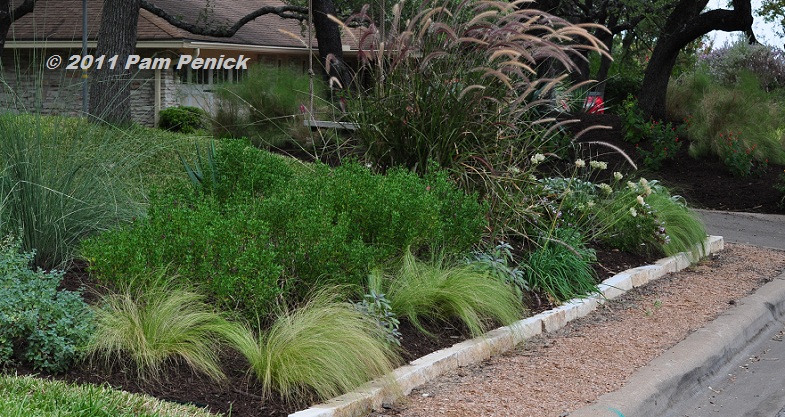
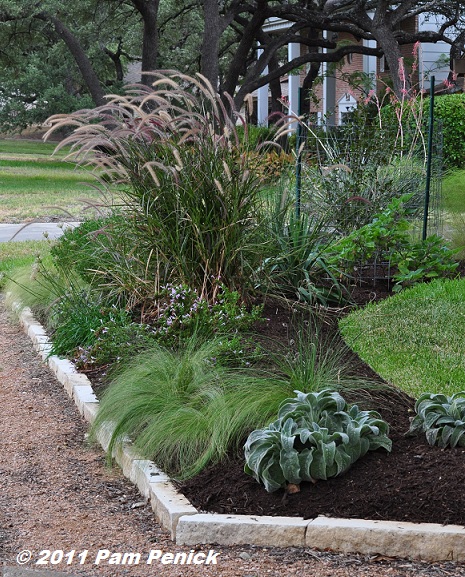
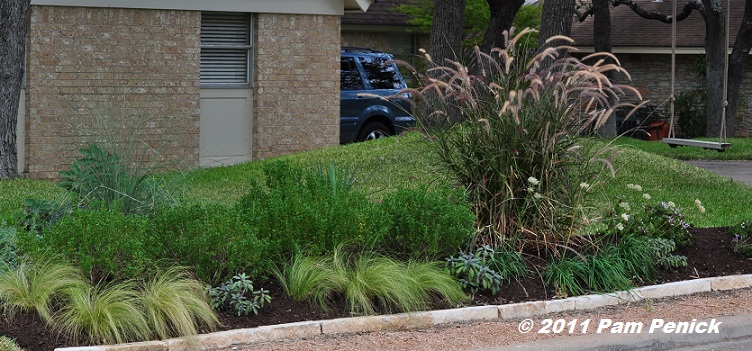
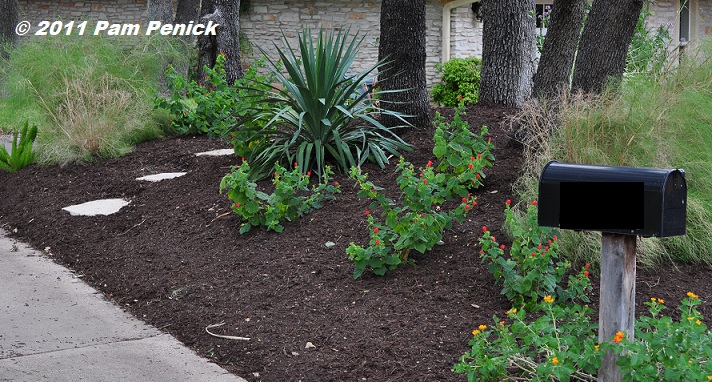
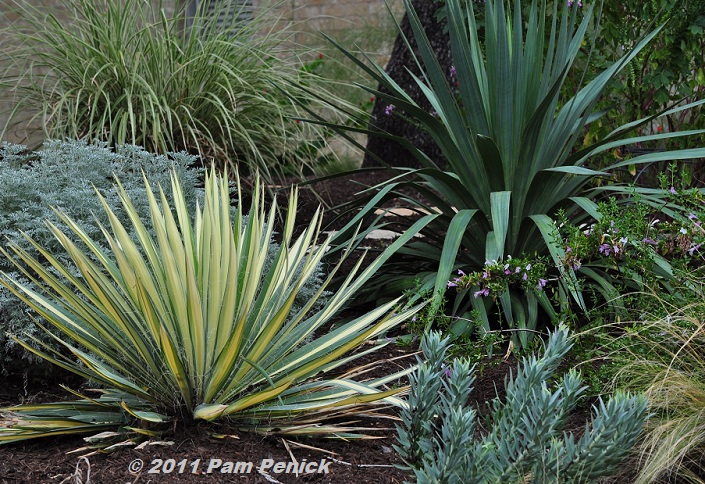
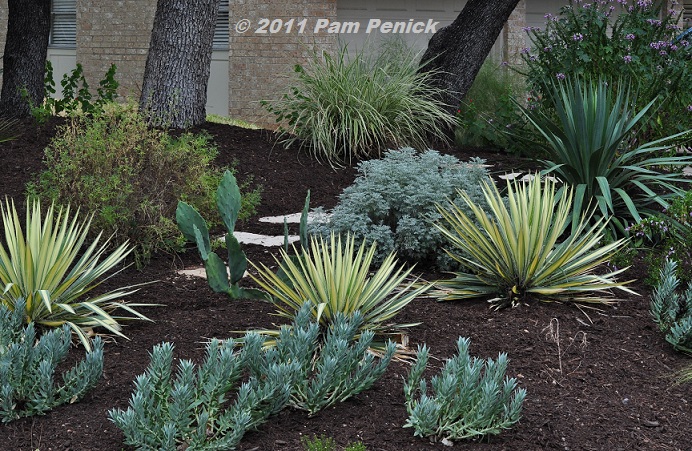
Wow..that bed came along quickly. Looks good.
Gives me even more ideas for redoing things out front here. I’m liking that color guard yucca more and more. Does it grow quickly?
Thanks for the long shots.
‘Color Guard’ grows fairly quickly, though not as fast as softleaf yucca, and it stays smaller overall. But its yellow-and-green stripes give it a zing that makes it really pop out in the garden. —Pam
It’s gorgeous, Pam! So much better than ratty, or even nice and green but thirsty lawn. Those Color Guard Yuccas are the best.
I think I saw ‘Color Guard’ yucca on your blog first, Frances. Thanks for the inspiration. —Pam
Wow, the big reveal and it looks great!
I’m making notes on the plant selections of course. The Lamb’s Ear looks so good, it doesn’t grow here even in the shade. Definitely believe the Copper Canyon Daisy didn’t like drought, I lost two this summer and only the one in a shady, well watered bed made it. Surprised about the Bamboo Muhly because I’ve been watching some in a parking lot and it seems to be doing well in pretty harsh conditions.
Thanks for sharing all the planning and details too.
I am really surprised that the copper canyon daisy suffered, even in this bed that I irrigated. I thought it was tougher than that. The bamboo muhly is very tough and shrugs off drought and heat. But it does not like temps that dip into the teens, especially for days at a time. —Pam
Dear Pam,
I am crazy about the ‘color guard’! It looks great with three and with the other shades of green. I like the combinations.
Jeanette
Thanks, Jeanette. That ‘Color Guard’ yucca is a favorite with everyone who sees it. —Pam
Nice design. Love Salvia greggi. Hmmm, could be the name. Greggo.
There are a number of Texas plants that you’d like, Greggo. How about Gregg’s mistflower, for example? It’s named for Josiah Gregg, a naturalist from TN who explored Texas in the mid-1800s and has 23 species named after him. His full story is found in the link. —Pam
My “hellstrip” has been planted with succulents and some annuals, but now it’s full of weeds. I have to get to the weeding but maybe I should add some grasses like in yours to fill it in.
I love my grasses! They add so much movement to the garden. —Pam
Were all the beds irrigated? Making plans for future xeriscaping with the house we’re building in the Hill Country…
All my beds are irrigated, Nila, especially if they’re under a year old (i.e., still getting established). Otherwise, after this summer, everything would be brown and crispy except yuccas, agaves, and maybe Mexican feathergrass. You have to irrigate to get plants established, even xeriscape and native plants. And even then, in a summer like this one, an established, very xeric bed would need a deep watering probably once every 2-3 weeks. I watered this bed on both watering days through the summer, and even then I nearly lost the possumhaw holly. It required several additional deep waterings to get it through. In previous “normal” summers, established, xeric beds like this may require watering only once every 2 weeks. But I don’t think we’re going to get “normal” next year either. —Pam
Your front garden really shows what foliage plants can do. A lovely combination of plants. Christina
Thanks, Christina! —Pam
I have noticed that more and more people are planting their ‘hell strips’ with sturdy perennials. A very encouraging trend in our part of the world.
Yes, it’s a gift to the neighborhood. —Pam
What do you recommend for folks with a narrow hell strip bordered by curb/street on one side and sidewalk on the other. I love your parking strip idea, but I don’t think it works in a neighborhood with sidewalks. Suggestions?
Robyn, in my former garden’s west-facing hell strip I paved two car-lengths with limestone for parking areas, and in between and at each end I planted low-growing, super-tough Mexican feathergrass and evergreen damianita. Click for a picture in spring, when both plants were in bloom. —Pam
Funny how your xeric plants can look so cool and happy as they thrive while everything around them turns brown and crispy from the heat and drought. Anxious to hear your recommendations for Robyn’s hell strip. As you know, I have one of my own begging for your influence.
Vicki, check out my reply to Robyn for one idea for a baking-hot hell strip. Thanks for your kind comment about my current garden. When established, it will be drought-tolerant. But I like to be up-front about the fact that I do water and groom my plants to keep them looking their best. Well-established, drought-tolerant plants can handle a certain lack of rain, but nothing is drought-proof. The evidence is all around us this year. —Pam
That is lovely Pam!
Thanks, Sheila! —Pam
Pam, I so appreciate your honest disclaimers about needing to water even xeric plants that are established. There’s no such thing as as a maintenance free garden. Yes, your planted hell strip is better looking than a lawn. Way better! gail
Thanks, Gail. I’ve had enough calls from potential clients looking for no-maintenance landscapes (no watering, no weeding, no nothing) that it’s time to work harder at debunking that myth. —Pam
The annual purple fountain grass is a great idea. I’m not sure if you’re talking about a species annual, or a species that is grown as an annual in Texas, but I’m pretty sure the species we grow where I am is a perennial and it does NOT age well, imo. Once it goes in it never seems to come out. Subsequent years’ growth is congested and ragged-looking. But I would definitely consider adding it to my garden as an annual. I’ve noticed people are starting to turn away from Mexican feather grass here (Nassella tenuissima–so weedy! Seeds germinate in cracks in my deck, and seedlings are a real pain to pull out of containers.
I’m on the same page as you, Chuck. I treat purple fountain grass as an annual. In mild winters it will return in central Texas, but it never looks as good as it did the first year. Most years it dies anyway, sparing the thrifty gardener the decision about whether to tear it out and start fresh. —Pam